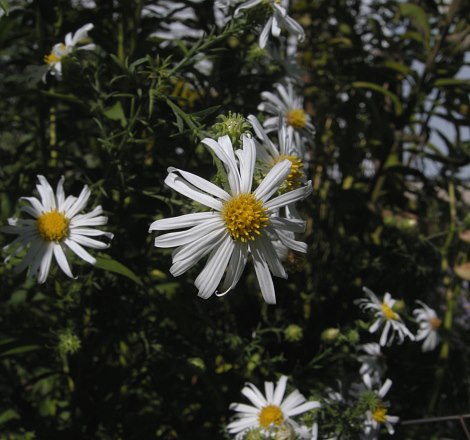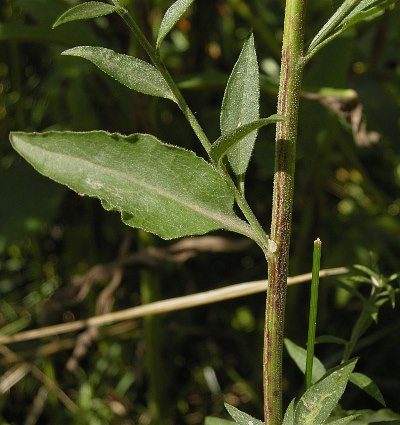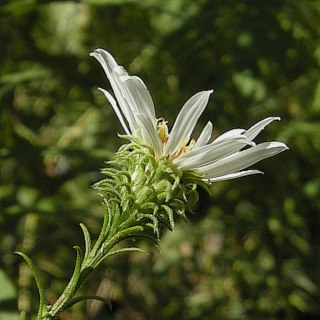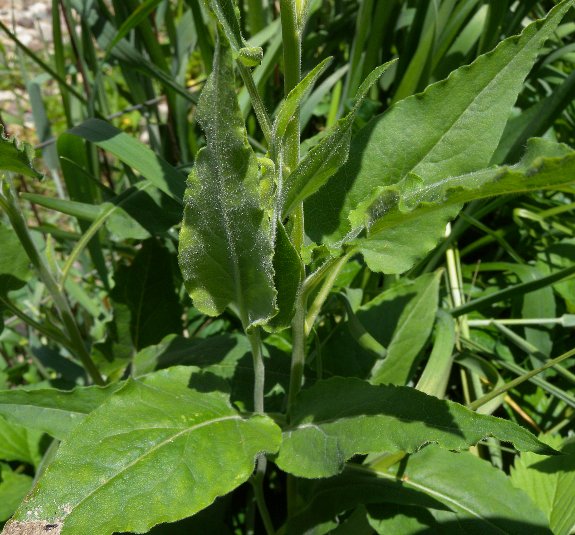Description: This perennial wildflower is 1-4' tall. Initially, evergreen basal leaves are produced, forming a rosette about 4-6" across; these leaves develop during the late fall and persist into the spring. Later, a central stem develops that becomes branched in the upper half. Both the central and lateral stems are terete and evenly pubescent. Along each stem, there are alternate leaves up to 4" long and 2½" across. These leaves are variable in shape: the lower leaves are cordate to ovate-cordate (like the basal leaves), the middle leaves are ovate-cordate to lanceolate, while the upper leaves are linear to short and scale-like. The alternate leaves become smaller in size as they ascend the stems. They are dull medium green, sparsely short-canescent on their upper surfaces, and more densely short-pubescent on their upper surfaces. The margins of the leaves are usually smooth, although some leaves may be sparsely dentate-crenate.

The central stem terminates in a panicle of flowerheads that is about twice as long as it is across; the stronger upper stems often produce smaller panicles of flowerheads. The collective weight of these flowerheads often causes the entire plant to lean partially sideways. Each daisy-like flowerhead is ¾–1¼" across, consisting of 20-35 rays florets and a similar number of disk florets. Depending on the local genotype of the plant, some flowerheads may have up to 50 ray florets, but this is less common. The ray florets of the flowers are usually blue-violet, but sometimes they are white. The disk florets are yellow, but become more orange-red colored with age. At the base of each flowerhead, there are several series of strongly recurved floral bracts. These bracts are linear-lanceolate in shape and usually finely pubescent. The blooming period occurs from late summer into the fall and lasts about 1-2 months. Usually, several flowers are in bloom at the same time. There is no noticeable floral scent. Each disk or ray floret is replaced by a small achene that is narrowly obovoid. At the apex of each achene, there is a small tuft of tawny hairs. These achenes are distributed by the wind. The root system is fibrous and short-rhizomatous. Older plants may produce a small caudex. Vegetative offsets can develop from the rhizomes.

Cultivation:
The
preference is partial sun, mesic to dry conditions, and soil containing
clay-loam or rocky-loam. Decaying organic material is beneficial to
growth and helps to retain moisture. Like other woodland asters, this
species often leans over to one side when it flowers.
Range & Habitat:
The native Many-Rayed Aster is largely restricted to west-central and
south-west
Illinois, where it is uncommon to occasional (see Distribution
Map). Elsewhere in the state, it is absent. This species is
endemic to the mid-section of the United States, where it is found
primarily in Arkansas, Missouri, and Illinois. Habitats include upland
oak woodlands, upland oak savannas, thinly wooded bluffs along major
rivers, partially shaded cliffs, rocky ledges, and various kinds of
glades (limestone, sandstone, chert, etc.). This aster is fairly
conservative ecologically, but it will adapt to minor levels of
disturbance and probably benefits from occasional wildfires.

Faunal Associations: The nectar and pollen of aster flowers attract a variety of insects, including long-tongued bees, short-tongued bees, Syrphid flies, bee flies, and small- to medium-sized butterflies (Robertson, 1929). A specialist pollinator of asters (Symphyotrichum spp.) is the bee, Andrena simplex. Many insects feed destructively on various parts of asters (leaves, flowerheads, stems, etc.), including the caterpillars of the butterflies Chlosyne nycteis (Silvery Checkerspot) and Phyciodes tharos (Pearl Crescent). Other insect feeders include leaf beetles, weevils, larvae of tumbling flower beetles, larvae of leaf-miner flies, larvae of gall flies, larvae of fruit flies, plant bugs, aphids, leafhoppers, scale insects, mealybugs, grasshoppers, katydids, larvae of twirler moths (Gelechiidae), larvae of Geometer moths, larvae of owlet moths (Noctuidae), and larvae of Tortrix moths (see Moth Table and Insect Table for more complete and detailed information about these species). The Ruffed Grouse and Wild Turkey feed on the leaves, flowerheads, and seeds of asters (especially those species occurring in woodlands and savannas). Mammals that feed on the foliage of asters include the White-tailed Deer, Elk, Cottontail Rabbit, Groundhog, and domesticated farm animals (Martin et al., 1951/1961; Schneider et al., 2006; Voigt Englund & Meyer, 1986; Myers et al., 2004; personal observations).

Photographic
Location:
The wildflower garden of the webmaster in Urbana, Illinois.
Comments:
There are many aster species in Illinois (over 35), and this is one
of the less common species. In many ways, Many-Rayed Aster resembles
the more common Symphyotrichum drummondii
(Drummond's
Aster), but the former has larger flowerheads (at least ¾" across) with
strongly recurved floral bracts. In contrast, Drummond's Aster (and
many other woodland/savanna asters) has flowerheads about ½–¾" across
and straight floral bracts. As the common name suggests, Many-Rayed
Aster has abundant ray florets (20-35 or more), while other
woodland/savanna asters typically have 10-20 ray florets. I am somewhat
partial to Many-Rayed Aster because it is easy to grow, the flowerheads
are a little larger in size, and they are usually more showy than the
flowerheads of other woodland/savanna asters. A scientific synonym of
this species is Aster
anomalus, and another common name is Cliff Aster.